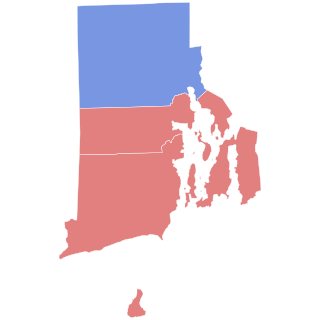
Presidential elections were held in the United States on November 5, 1968. Republican nominee, former vice president Richard Nixon, defeated both the Democratic nominee, incumbent vice president Hubert Humphrey, and the American Independent Party nominee, former Alabama governor George Wallace.

The 1968 United States House of Representatives elections were elections for the United States House of Representatives on November 5, 1968, to elect members to serve in the 91st United States Congress. They coincided with Richard M. Nixon's election as president. Nixon's narrow victory yielded only limited gains for his Republican Party, which picked up a net of five seats from the Democratic Party. The Democrats retained a majority in the House.

Lyman Underwood Humphrey was the 11th governor of Kansas.

The 2008 congressional elections in Michigan were held on November 4, 2008, to determine who would represent the state of Michigan in the United States House of Representatives. Michigan had fifteen seats in the House, apportioned according to the 2000 United States census. Representatives are elected for two-year terms; those elected will serve in the 111th Congress from January 3, 2009, until January 3, 2011. The election coincided with the 2008 U.S. presidential election.

From March 8 to June 7, 1960, voters and members of the Democratic Party elected delegates to the 1960 Democratic National Convention through a series of caucuses, conventions, and primaries, partly for the purpose of nominating a candidate for President of the United States in the 1960 election. The presidential primaries were inconclusive, as several of the leading contenders did not enter them, but U.S. Senator John F. Kennedy of Massachusetts emerged as the strongest candidate and won the nomination over Lyndon B. Johnson at the convention, held from July 11 to 15 at the Los Angeles Memorial Sports Arena.

The 1962 Kansas gubernatorial election was held on November 6, 1962. Incumbent Republican John Anderson Jr. defeated Democratic nominee Dale E. Saffels with 53.4% of the vote.

The 1958 Kansas gubernatorial election was held on November 4, 1958. Incumbent Democrat George Docking defeated Republican nominee Clyde M. Reed Jr. with 56.46% of the vote.

The 1970 Rhode Island gubernatorial election was held on November 3, 1970. Incumbent Democrat Frank Licht narrowly defeated Republican nominee Herbert F. DeSimone with 50.07% of the vote.

The 1950 Kansas gubernatorial election was held on November 7, 1950. Republican nominee Edward F. Arn defeated Democratic nominee Kenneth T. Anderson with 53.77% of the vote.

The 1908 Kansas gubernatorial election was held on November 3, 1908. The Republican nominee Walter R. Stubbs defeated the Democratic nominee Jeremiah D. Botkin, with 52.49% of the vote.

The 1902 Kansas gubernatorial election was held on November 4, 1902. Republican nominee Willis J. Bailey defeated Democratic nominee W. H. Craddock with 55.45% of the vote.

The 1900 Kansas gubernatorial election was held on November 6, 1900. Incumbent Republican William Eugene Stanley defeated People's Party nominee John W. Breidenthal with 52.25% of the vote.

The 1898 Kansas gubernatorial election was held on November 8, 1898. Republican nominee William Eugene Stanley defeated People's Party incumbent John W. Leedy with 51.81% of the vote.

The 1896 Kansas gubernatorial election was held on November 3, 1896. People's Party nominee John W. Leedy defeated incumbent Republican Edmund Needham Morrill with 50.55% of the vote.

The 1888 Kansas gubernatorial election was held on November 6, 1888. Republican nominee Lyman U. Humphrey defeated Democratic nominee John Martin with 54.68% of the vote.

The 1880 Kansas gubernatorial election was held on November 2, 1880. Incumbent Republican John St. John defeated Democratic nominee Edmund G. Ross with 57.90% of the vote.

The 1890 Rhode Island gubernatorial election was held on April 2, 1890. Democratic nominee John W. Davis defeated incumbent Republican Herbert W. Ladd with 48.76% of the vote.

The 1906 Tennessee gubernatorial election was held on November 6, 1906. Following the death of Senator William B. Bate in March 1905, governor James B. Frazier quickly convened the General Assembly and had himself elected to the vacant Senate seat. John I. Cox, who as speaker of the state senate was Frazier's constitutional successor, then became governor. Malcolm R. Patterson narrowly defeated governor Cox for the Democratic nomination. In the general election, Patterson defeated Republican nominee Henry Clay Evans with 54.42% of the vote. Evans also ran for governor in 1894, but narrowly lost.

The 1900 Tennessee gubernatorial election was held on November 6, 1900. Incumbent Democratic governor Benton McMillin defeated Republican nominee John E. McCall with 53.86% of the vote.

The 1884 Tennessee gubernatorial election was held on November 4, 1884. Incumbent Democratic governor William B. Bate defeated Republican nominee Frank T. Reid with 51.24% of the vote.






















